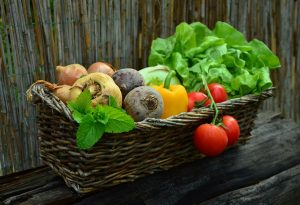Have you ever wondered what grows Moroccan vegetables? We surely have. This is why we chose to write this essay. We have collected a large quantity of cultivated Moroccan vegetables.
Potato
This is a widely grown Moroccan vegetable and has great nutritional value, as it contains a lot of vitamin C, potassium, iron, magnesium, phosphorus, and protein.
It also has B-complex vitamins, although not in sufficient quantities to be called an essential nutrient. The potato contains starch, which aids digestion.
Onions
Onions are frequently grown in Moroccan vegetables and include a variety of vitamins; also, onions have a water level of approximately 50%.
That is a lot of liquid! Onions are used to flavor foods as well as to prepare stews and soups. They are also edible raw.
Carrots
Carrots are widely grown over the world and are high in nutrients. They have vitamin A, iron, potassium, phosphorus, and other nutrients in them.
Carrots are often steamed before eating, however, they can also be eaten raw if desired.
Turnips
Turnips are a popular vegetable that may be used in a variety of ways. They are high in calcium, vitamin K, and vitamin C.
Turnips can be steamed and added to salads, mashed potatoes, soups, and a variety of other delicious recipes.
Cayenne peppers
Moroccan cuisine makes extensive use of these peppers. Typically, they are filled with meat, rice, or veggies. Bell peppers are high in fiber and high in vitamin C.
Sprinkle salt on bell pepper strips or stir-fried bell pepper strips during cooking to add flavor.
Zucchini
Zucchini is one of the most popular vegetables in the world. It contains few calories and fat and is high in vitamin C, magnesium, phosphorus, and fiber.
Zucchinis are often served as a side dish after being steamed. You may also eat these hot from the oven like chips.
Peas
Peas are commonly farmed in Morocco. They are highly versatile; they can be sautéed, boiled, baked, or even turned into soup.
This vegetable contains protein, vitamin D, and fiber. Morocco grows a variety of peas.
String Beans
String beans are another tasty vegetable. They have a spicy and sweet flavor that complements most dishes.
String beans are high in folic acid, vitamin C, fiber, and manganese. String beans are often used in salads, soups, and stir-fries. But there are numerous ways to prepare them.
Cucumber
This delicious vegetable can be consumed raw or cooked. It provides vitamin C, fiber, calcium, and folate. It tastes finest when it is fresh.
Some individuals love dipping cucumbers in dips such as hummus or other types of dip.
Artichoke
This vegetable is reported to flourish in Mediterranean conditions ranging from Spain to Italy.
Artichokes are high in antioxidants and nutrients like vitamin E, vitamin C, riboflavin, niacin, and thiamine.
These antioxidant powerhouses aid in the fight against free radicals, which cause harm to our bodies. Artichokes are typically steamed and served on their own.
They can also be sliced and mixed into salads, pasta, or seafood meals.
Lentils
Lentils are another famous bean that has been enjoyed since ancient times. Lentils are high in protein, fiber, vitamins, and minerals.
Lentils are commonly served with couscous or rice in Moroccan cuisine. They can also be used with eggs to make a quick morning dish.
Broccoli
This vegetable is high in vitamin C and fiber. Broccoli is exceptionally hearty because its branched stalks contain more of this vitamin than the heads.
Broccoli is a member of the cabbage family and is finest when young and tender. Broccoli stems can be removed and sliced into chunks to use in stir-fries or as a substitute for spaghetti.
Cauliflower
Cauliflower, like broccoli, is a member of the cruciferous vegetable family, which also includes kale, mustard greens, collards, Brussels sprouts, and kohlrabi.
Cauliflower, unlike broccoli, requires no preparation. Simply cut it up and add it to any salad or sauce.
Cauliflower is a multipurpose vegetable that you have most likely heard of.
Chard
Chard is a leafy green vegetable that resembles spinach but is slightly less bitter. Chard is incredibly nutritious. It’s high in iron, potassium, beta-carotene, and vitamins A and C.
Chard is a fantastic supplement to any vegetarian diet. To add flavor to your favorite pasta sauce, chop up chard leaves and sprinkle them in.
Chard is not only good for you, but it is also a flavorful vegetable that you will appreciate.
Sunchoke
You’ve probably never heard of Sunchoke. They are an obscure veggie. So, what precisely are they?
These root vegetables come in two varieties: white sunchokes and purple sunchokes. Sunchokes are endemic to North America and Europe.
They are high in fiber and vitamin B6. If you want to prepare a nutritious snack, try cutting up some sunchokes and eating them like potato chips.
Asparagus
Asparagus is one of my favorite vegetables. I like it roasted with olive oil and lemon juice. Asparagus contains vitamin K, folate, fiber, and a variety of other critical elements.
You don’t have to eat it plain either. For a delicious side dish, combine it with tomatoes, olives, feta cheese, and basil.
Pumpkin
Pumpkins are not only delicious, but they are also nutritious! Pumpkin seeds are high in zinc, magnesium, selenium, and copper.
Pumpkin seed oil is used in cooking and baking because it imparts a nutty flavor to meals. Add pumpkin seeds to oatmeal, cookies, and muffins for extra nourishment.
Eggplant
Eggplants, like tomatoes, peppers, and potatoes, are members of the nightshade family. Eggplants are high in dietary fiber, vitamin A, potassium, manganese, phosphorus, copper, folate, and protein.
Eggplant is typically filled with herbs or spices. They can be grilled whole or sliced and put in a tomato sauce.
Cabbage
Cabbage is a member of the brassica (broccoli) family and is high in calcium, vitamin C, folic acid, and fiber.
Cabbage is also abundant in antioxidants, which fight against cancer. Cabbage is accessible all year and comes in a variety of flavors.
Slice the cabbage thinly and brown it in butter, garlic, and onions. After that, season with salt and pepper to taste. Serve over spaghetti or as a side dish.
Kale
Kale comes in thousands of varieties. Kale is a member of the Brassica genus. Kale is high in fiber, calcium, vitamin C, manganese, and riboflavin.
Kale is quite adaptable. Use it fresh in salads, cooked in soups, or sliced thin and pan-fried.
Sugar Beets
Sugar beets are sometimes known as taproot or beetroot. Sugar beet has a sweet, earthy flavor and is a member of the Beta vulgaris subspecies.
This vegetable is high in natural sugars. The roots are frequently peeled and boiled or roasted. They can be eaten alone or with apples, pears, oranges, bananas, peaches, apricots, carrots, and parsnips.
Lettuce
Lettuce is a member of the lettuce family. Lettuce contains more than 50% water.
They supply minerals such as calcium, magnesium, phosphorus, sodium, sulfur, chlorine, bromine, iodine, iron, potassium, copper, zinc, and manganese.
Lettuce is available all year long. It’s best when it’s new and fresh. Wash the leaves and remove them. Cut them into bite-size pieces. Drizzle with lemon juice immediately before serving.
Spinach
Spinach is a leafy green that grows well in chilly conditions. Spinach is high in vitamins A and C, iron, folic acid, niacin, pantothenic acid, thiamin, biotin, magnesium, vitamin D, and potassium.
It is one of the most nutrient-dense greens available. Consume spinach both raw and heated. Allow spinach to cool for 2 minutes after steaming. Rinse with cold water, drain, and serve immediately.
Tomato
Tomatoes are widely farmed in Morocco, and they have a long history in the country, having been introduced by Arabs from North Africa.
Tomatoes were initially cultivated in the Maghreb (Northwest Africa) in the 10th century, but they did not become popular throughout the country until the 15th century.
Although the tomato is officially a fruit, it is typically recognized as a vegetable and appears in many of our savory recipes.
Final Thoughts
This concludes the article. While not have many uncommon Moroccan vegetables, it does produce many of the commonly consumed fruits and vegetables.
There are hundreds of plants other than Moroccan vegetables; if you are interested in knowing more, we strongly advise you to do some research and widen your horizons.



